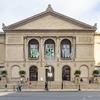More about Mrs. Daniel Hubbard (Mary Greene)
- All
- Info
- Shop

Sr. Contributor
Mrs. Daniel Hubbard (Mary Greene) by John Singleton Copley is like a petticoated version of what happens when you cross The Brady Bunch with Clueless (but more on that later).
Mary Greene was born in Colonial Massachusetts in 1734, placing her at about 30 years old when Copley painted this in 1764. Her father, Thomas Greene, was a fabulously wealthy Bostonian merchant and director of the Massachusetts Bank. He paid the fifth highest taxes in all of Boston. Within a decade, the exorbitant taxes imposed by the British Crown would inflame Bostonians to make like sorority girls and don culturally appropriated Native American costumes to dump tea into the harbor; tea which just happened to be consigned to Copley’s father-in-law. Such political strife drove the British-born artist from the colonies ahead of the American Revolution. Mary’s own Husband, Daniel Hubbard, whose portrait by Copley also hangs in the Art Institute of Chicago, was a loyalist who similarly fled the colonies due to the Revolution; first to England, then to South America, before being pardoned and returning to Boston.
The British hadn’t fallen quite so out of fashion by 1764, and Copley made a lucrative business of painting vanity portraits for the colonial elite that aped English aristocracy in the grand manner of Allan Ramsay and Johann Zoffany. Despite the vivid individualism of Mary’s facial features in this portrait (a hallmark of Copley’s), she likely never appeared in a dress or scene like this. The elaborate gown, stately pose, and neoclassical background are direct copies from an engraving of a British noblewoman. Copley painted similar portraits of Mary’s stepbrother (spoiler alert, he was also her aforementioned husband), father, and stepmother. Like any good fairytale crossed with an eighteenth-century courtship novel, things start to get interesting when stepmothers and eligible male relatives entered the picture.
Mary’s mother, Elizabeth Gardiner Greene, may have been born in Salem just a generation after the notorious witch trials. Her untimely death left Thomas Greene a rich widower with a brood of motherless children to raise. He consoled himself with his dead wife’s cousin, Martha Coit Hubbard, herself recently on the market as the widowed mother of several children. Martha was the daughter of a shipbuilder and his wife, Mahetabel Chandler Coit, author of possibly the earliest diary known to exist written by a woman in Colonial North America. Martha herself wrote detailed letters, noted for their wit and vivacity, often included in publications of her mother’s writings. According to Martha’s letters, Thomas “pursued her relentlessly with great charm.” Martha eventually gave in and the couple wed, merging their respective offspring, and that’s the way they all became the Hubbard bunch.
The families blended together easily; through a modern lens, rather too easily. Mary Greene married Daniel Hubbard, her own stepbrother, who is the subject of the companion portrait. Several of their respective siblings also married each other. Wedlock between relatives, whether by blood or marriage, was of course common in the period. For example, the Hubbards’ fellow Massachusettsans and contemporaries, future first couple John and Abigail Adams, were third cousins, and their grandson via John Quincy Adams married his first cousin. Certainly stepsibling love would not have been considered taboo in that cultural context, but Cher Horowitz probably should have known better in 1995 Beverly Hills. In any case, the marriage was a fruitful one. Mary and Daniel had seven children. The Hubbards liked to keep it in the family in more than one way. This painting was passed from generation to generation for nearly 200 years until the Institute acquired it in 1947.
Sources
- Art Institute Chicago. “Mrs. Daniel Hubbard (Mary Greene).” Accessed March 23, 2022. https://www.artic.edu/artworks/59787/mrs-daniel-hubbard-mary-greene.
- Editors, History.com. “John Quincy Adams’ son marries relative at the White House.” History.com, A&E Television Networks. Last modified March 4, 2021. https://www.history.com/this-day-in-history/john-quincy-adams-son-marri….
- Omeka at Brandeis. “The Destruction of the Tea in Boston Harbor (The Boston Tea Party) Part I.” Accessed March 23, 2022. https://omeka.lts.brandeis.edu/exhibits/show/copley_bostonteaparty/copl….
- WikiTree. “Daniel Hubbard Jr. (1736 - 1796).” Accessed March 23, 2022. https://www.wikitree.com/wiki/Hubbard-781.
- WikiTree. “Elizabeth (Gardiner) Greene (1705 - 1744).” Accessed March 23, 2022. https://www.wikitree.com/wiki/Gardiner-479.
- WikiTree. “Martha (Coit) Greene (1706 - abt. 1784).” Accessed March 23, 2022. https://www.wikitree.com/wiki/Coit-48.
- WikiTree. “Mary (Greene) Hubbard (1734 - 1808).” Accessed March 23, 2022. https://www.wikitree.com/wiki/Greene-1259.
- WikiTree. “Mehetabel (Chandler) Coit (1673 - 1758).” Accessed March 23, 2022. https://www.wikitree.com/wiki/Chandler-720.
- WikiTree. “Thomas Greene (aft. 1705 - 1763).” Accessed March 23, 2022. https://www.wikitree.com/wiki/Greene-638.












